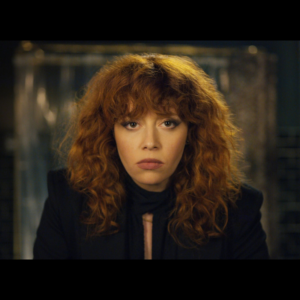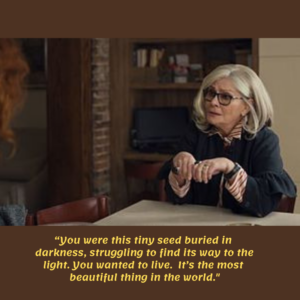Russian Doll: A Beautiful Parable for Grieving

*Spoiler alert. If you haven’t seen the show you can watch it now and then return to the article.*
Netflix’s Russian Doll is an 8 part series that at the same time stretches the mind whilst also articulating some pretty deep themes about trauma, grief and the ways in which we get stuck in our own hells.
The series begins with 36-year-old Nadia, a tough fiery computer programmer, living and then dying over and over again through a continuous loop on her birthday. In order to free herself from this torturous glitch she must be willing to look deep inside herself instead of trying to find the answers in her external life. What she eventually discovers allows her to push past the wall of stone that is within her psyche and grieve the hidden losses of her childhood. By thus doing, she unfreezes her heart to find her life force and her connection with others. It is ultimately through this soul work that she is freed from the loop of continuous premature death.
In her first attempts to get to the bottom of her predicament, she seeks out the possibilities in her external world. At first she thinks she has gone mad, then she is convinced it is from a joint that she smoked, and finally she tries to see if the old yeshiva school where the party takes place could be haunted. All of these searches end in her death. As much as she wishes it to be true, there is no outside cause for her internal suffering. One of the ways that Nadia tries to find answers is through discussion with her mentor, the amazing trauma therapist Ruth. Ruth is the guiding mentor of the show, which is fitting because the entire show could be seen as a metaphor for therapy. Just like in therapy, the therapist can only be a guide and support; you yourself must do the soul work that will get you out of the cycle of self-destruction. Ruth advocates for therapists as mirrors to the self, “People need therapists because we are terrible narrators of our own stories”, she says and this is the key to Nadia’s release.
After exhausting all of the possibilities in her external world she finally meets Alan. As they plummet to their deaths in an elevator Nadia turns to him and says, “did you get the news? We’re about to die.” And Alan says “Oh I die all the time.” Bingo, a link, a clue, another fellow sufferer. Now the two become a team, two broken souls, trying to get to the bottom of the bizarre predicament that faces them. In their desperation, the two let down their respective defenses just a little bit for the comfort of having found another sufferer. Unable to face the true nature of their self-destructive patterns alone they begin to see and reflect it in each other. In order to break the repeating patterns that eventually destroy them they need to face their trauma and grieve for the pain that they have been carrying. The show reminds us that the support of others is crucial in life, we need loving community in order to face our demons; we simply cannot do it alone.
The penultimate episode, called “The Way Out” wisely tells us that the only way out is to go within. As much as she tries to avoid it, wherever she turns Nadia sees her little girl past self. The mood becomes darker and more terrifying as she enters the lonely space of her deepest psyche. Each time she turns away she dies from a heart attack, she simply cannot bear the pain of her reflection. In a terrifying scene in the grocery store, Nadia finally approaches the little girl who won’t leave her alone. With tears in her eyes, the little girl smiles as if to say, “you found me”; the little girl who stands before her is she.
Nadia’s wounding is deep and pervasive, as she puts it, “my past self is lost and trapped between the past and the present.” In desperation she runs to Ruth and reveals her deepest shame, a terrible thing that she did and has been carrying with her all these years. She blamed herself for abandoning her unstable mother as a little girl. She was supposed to be her mother’s savior, “her trusty sidekick”. By abandoning her she internalized the belief that she was the reason why she committed suicide. Ruth helps to reflect back the truth that she was a child and not responsible for anything, she was not the one who made the decision; no one was going to let her continue to live with her unstable mother. For all of these years Nadia has felt shame for her inner secret wish to leave her mother. What a beautiful way to show how children interpret the world around them and take on the responsibility for the pain of their parents. Ruth reminds her “You were this tiny seed buried in darkness, struggling to find its way to the light. You wanted to live. It’s the most beautiful thing in the world. Do you still have that in you?” As Nadia finally lets her grief out, Ruth tells her that she sees her searching for death on every corner of this world, “where is that part of you, that gorgeous piece of you pushing to be a part of this world?” Nadia cannot grieve until she lets go of the shame she carries and believes that her loss is worthy of grief.

By coming into contact with her grief, she sinks closer to the root of her despair without dying. It is only then that she can access the wisdom within herself, “the life force” which leads her to compassion for her little girl self. In a symbolic act of life and connection, she passes on the book “Emily of New Moon” to the lonely daughter of an ex. The episode ends with “Are you ready to let her die? This is the day we get free”.
Only by experiencing our deepest grief can we find the portal to life. As the psychotherapist Francis Weller eloquently writes, “ Grief is a powerful solvent, capable of softening the hardest places in our hearts. When we can truly weep for ourselves and those places of shame, we have invited the first soothing waters of healing to wash through our souls. Grieving, by its very nature confirms worth. I am worth crying over; my losses matter.”
Allowing yourself to face the truth of yourself and all of your split off parts ultimately leads to major release, which is what the final episode, ‘Ariadne’, represents. By facing their own self-loathing through grief, Nadia and Alan can finally let go and open themselves up to love and being loved.
So what is the message of the story in a nutshell? Life is hard, it’s impossible to do it alone, find the root of your issues, seek out like minded supports, speak to a therapist and don’t be afraid of the riches that come after the dark night of the soul.

